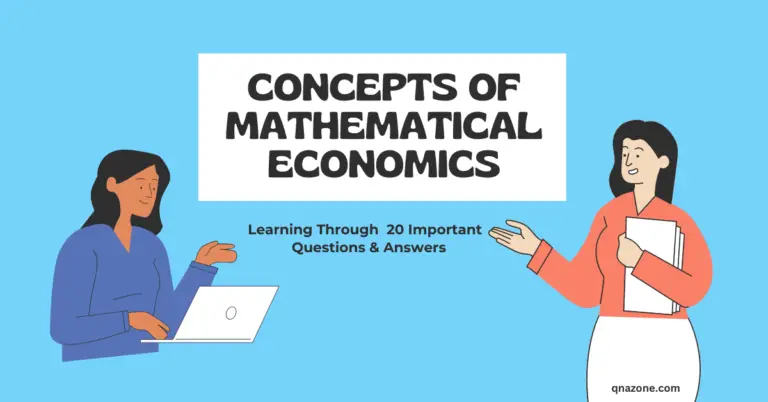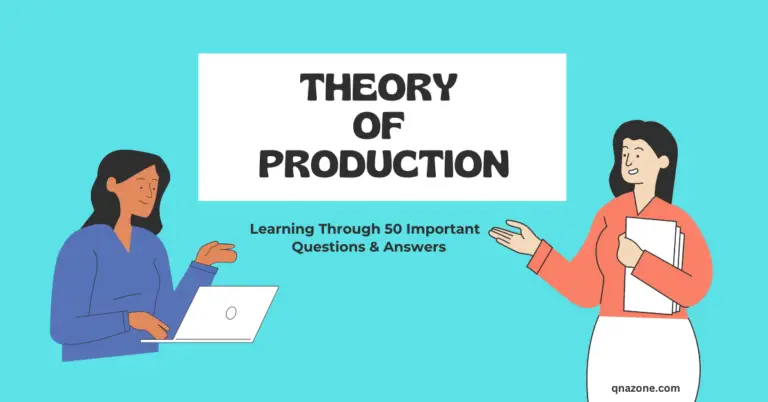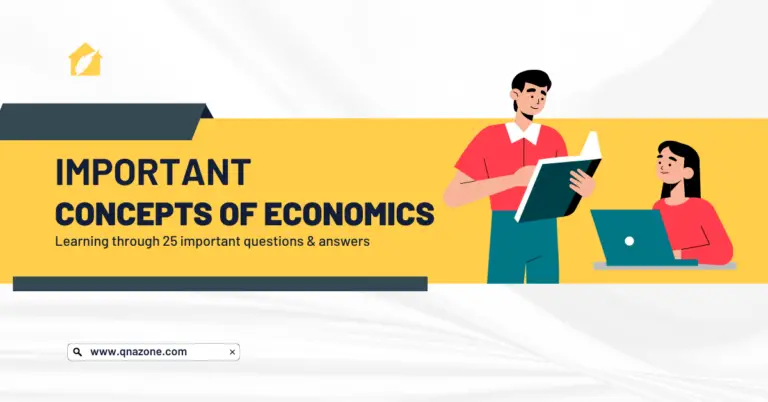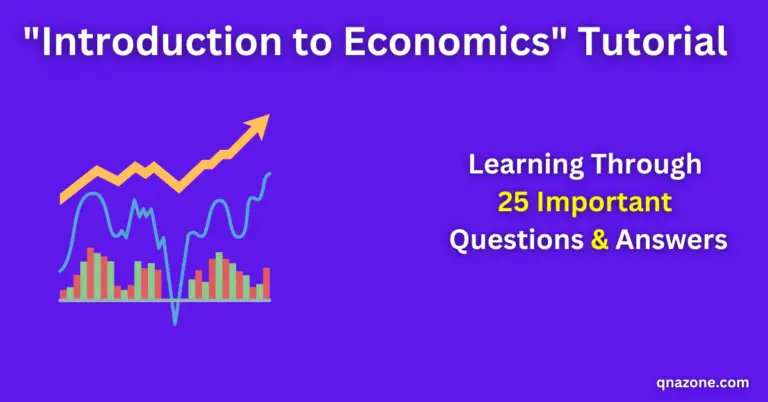30 Important Theory of Cost Questions and Answers [With PDF]
The 8th chapter of our economics learning course is “Theory of Cost.” In this article, we’ll learn the 30 most important “theory of cost” questions and their answers.
These simple questions and answers will assist you in quickly grasping the fundamental concepts of the theory of cost, such as what production cost is, what the theory of cost is, different types of costs, cost functions, the economics and diseconomies of scale, and much more.
By reading this post, you can quickly prepare for economics courses and other competitive exams such as Vivas, job interviews, and school and college exams.
So let’s get started.
30 Theory of Cost Questions and Answers
The 30 most important “theory of cost” questions and answers are as follows:
Question 01: What is the production cost?
Answer: Production costs are the money that a producer spends on making a good or service at a certain point in time.
Question 02: What is the theory of cost?
Answer: The theory of cost analyzes the relationship between cost and output, i.e., how production costs change in response to changes in output.
Question 03: What is the financial cost?
Answer: The amount of money needed to make a certain number of goods and services at a certain time is called the financial cost of production. That is, worker wages, raw material costs, rent, interest, organizer dues, and so on are all included in the total financial cost.
Question 04: What is the explicit cost?
Answer: The “explicit cost” refers to expenditures for materials purchased directly from the market. such as wages, interest, rent, the cost of raw materials, etc. It is also called “accounting costs.”
Question 05: What is the implicit cost?
Answer: “Implicit cost” refers to inputs that aren’t bought directly from the market but are instead provided by the producers themselves, such as their own labor, capital, and land costs.
Question 06: What are the economic costs?
Answer: Economic costs, in addition to all accounting costs, including all implicit costs that the entrepreneur could have earned if he had invested his own money and sold his own services for the next best alternative use.
Economic costs = Accounting costs + Implicit costs
Question 07: What does the opportunity cost?
Answer: The amount of money lost by foregoing the best alternative for producing a good is referred to as its “opportunity cost.”
Question 08: What is the private cost?
Answer: A company’s private cost is the expense of producing a commodity. It is the total of explicit and implicit costs since a company takes both into account when deciding how to make a product and how much to charge for it.
Question 09: What is the social cost?
Answer: The social cost of economic activity is the cost to society as a whole. In other words, the social cost is the sum of the private cost and the difference between negative and positive externalities.
Question 10: What is the cost function?
Answer: The functional relationship between the cost of production and output is called the cost function.
In terms of mathematics, C = f (Q);
Where,
C = Cost of production
Q = Production
Question 11: What are the short-run production costs?
Answer: The term “short run” refers to a time period during which at least one factor of production is fixed and cannot be changed—for example, machinery, firm size, buildings, technology, and so on.
But the variable inputs used in the making process can be changed to increase or decrease production. For example, the amount of production can go up or down if the amount of raw materials, labor, wages, electricity, and so on goes up or down.
Short-run production costs are those incurred on variable materials in the short run.
Question 12: What are the long-run production costs?
Answer: In the long run, all of the factors that go into production can be changed to increase or decrease production. In the long run, the firm has no fixed costs. All production costs are considered variable costs.
In the long run, it is possible to increase or decrease the size and volume of the firm by changing the firm’s fixed costs. In short, the total cost of production is the sum of the firm’s short-run fixed and variable costs. In the long run, however, there is no such thing as a firm’s fixed costs. All costs are variable costs.
Question 13: What is the difference between short-run and long-run production costs?
Answer: The following are the differences between short-run and long-run production costs:
| Sl No | Short-run production cost | Long-run production cost |
| 1. | Short-run costs are divided into two categories: (a) fixed costs and (b) variable costs. | In the long run, there is no such thing as a fixed cost. All costs are variable costs. |
| 2. | In general, the firm’s size and scope cannot be reduced or increased, i.e., changed in the short run. | In general, the firm’s size and scope can be reduced or expanded, i.e., changed, in the long run. |
| 3. | The short-run cost equation is: STC=TFC+TVC | The long-run cost equation is: LTC=LTVC |
Question 14: What is a fixed cost?
Answer: Fixed costs are those costs that are unrelated to the volume of production, i.e., they do not change as the volume of production increases or decreases. In general, fixed expenses include house rent, rent, long-term loan interest, official salaries, etc.
Question 15: What is a variable cost?
Answer: Variable costs are costs that fluctuate as a result of changes in the production volume of an organization. When production increases, variable costs rise, and when production decreases, variable costs fall. Some examples of variable costs are worker wages, the cost of buying raw materials, and electricity bills.
Question 16: What is the meaning of the term “short run”?
Answer: The short run is the time period during which a company or industry cannot change the fixed inputs used in production.
Question 17: What is the meaning of the term “long run”?
Answer: The long run is the time period during which all production inputs are variable and the firm can enter or exit the industry.
Question 18: What is the total variable cost (TVC)?
Answer: Total variable cost (TVC) refers to the amount of money spent by a company on variable factors of production. This cost includes things like the cost of production labor, raw materials, fuel, general repairs and maintenance of machinery, the current cost of fixed capital, and so on.
Question 19: What is the average cost?
Answer: The average cost is calculated by dividing the total cost of production by the number or quantity of products manufactured. Thus, the cost of producing each unit of a product is known as the average cost.
Average cost = (Total cost of production/ Number of products manufactured)
Question 20: What are the types of average costs?
Answer: There are three types of average costs:
- Average fixed cost (AFC)
- Average variable cost (AVC) and
- Average total cost (ATC).
Question 21: What is the average fixed cost (AFC)?
Answer: The average fixed cost is calculated by dividing total fixed costs by total output. For example, if the total cost to produce 10 units is $500, the average fixed cost is $50.
Average fixed cost (AFC) = (Total fixed cot/Total output)
Question 22: What is the average variable cost (AVC)?
Answer: The average variable cost is calculated by dividing the total variable cost by the total output. For example, if the total variable cost associated with producing 10 units is $100, the average variable cost will be $10.
So, average variable cost =( total variable cost / total output.)
Question 23: What is the average total cost (ATC)?
Answer: The total cost of output per unit is defined as the average total cost. It is the sum of the average fixed and variable costs.
ATC = AFC + AVC
Question 24: What is the marginal cost?
Answer: The marginal cost is the additional cost of producing one additional unit of a good. Marginal cost is the amount by which the total cost of production increases or decreases when total output increases or decreases by one unit.
For example, the cost to produce five pens is $40.00. As a result of producing one additional unit, or six pens, the production cost rises to $48.00. In this case, the cost of producing an extra pen is (48.00 – 40.00) = $8.00. So the marginal cost is $8.00.
Question 25: What is the long-run marginal cost curve?
Answer: The long-run marginal cost (LMC) cost curve shows how the total cost changes when one more unit of output is made. This is because all inputs can change. The short-run marginal cost curve serves as the foundation for the LMC.
Question 26: What are the economics of scale?
Answer: The term “economies of scale” refers to cost savings achieved by increasing the scale of output or the size of the plant.
Question 27: What are the diseconomies of scale?
Answer: Diseconomies of scale happen when the average cost of a plant’s output goes up as its size grows.
Question 28: What are the internal economies of scale?
Answer: Internal economies of scale are linked to an increase in the firm’s output scale and are caused by the growth of the company’s industry.
Question 29: What are the internal diseconomies of scale?
Answer: In the long run, a variety of factors may cause an increase in a firm’s average cost. These diseconomies are linked to management issues, either directly or indirectly.
Question 30: What are the external economics of scale?
Answer: These economies are those that a firm reaps not as a result of its own efforts and increased scale, but as a result of the expansion and growth of the industry to which it belongs, as well as the overall development of the economy and markets.
I hope you have a good understanding of the “Theory of Cost“ chapter by the end of this post.
If you read these 30 important “theory of cost” questions and answers on a regular basis, you will gain a better understanding of the chapter.
Don’t forget to leave a comment for us if you have any questions or if you would like to find out more information.
You can also read:
- Introduction to Economics Questions and Answers [With PDF]
- Important Concepts of Economics Questions and Answers [With PDF]
- Important Theory of Consumer Behavior Questions and Answers [With PDF]
- Important Basic Elements of Demand Questions and Answers [With PDF]
- Important Basic Elements of Supply Questions and Answers [With PDF]
- Important Theory of Production Questions and Answers [With PDF]






